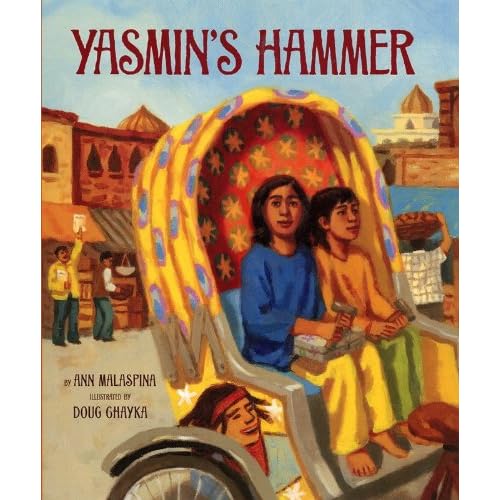 Title: Yasmin's Hammer
Title: Yasmin's HammerAuthor: Ann Malaspina
Illustrator: Doug Chayka
Copyright Date: 2010
Genre: Fiction
Theme: child labor, education, Bangladesh
Grades: 3-4
Awards: the 2010-2011 Asian/Pacific American Award for Literature, Horace Mann Upstanders Children's Literature Award, Honor Book, Best Children's Books of the Year by Bank Street College of Education, Notable Children's Books by Smithsonian Magazine
Summary
Once living near a paddy field in Bangladesh, Yasmin and her family move to the city of Dhaka after a cyclone destroys their home. In order to pay for their home there her Abba (father) must run a rickshaw, her Amma (mother) cleans in a wealthy home, and Yasmin and her sister Mita work breaking bricks for concrete. Yasmin has dreams of going to school, but whenever she tells her parents they say, "Not yet." One day she starts receiving tips from her boss for her hard work and she saves her money under her bed.
What is she going to purchase with her secret stash of money and will her family be able to help her live her dream of going to school? Read this book to find out.
Pre-reading Activity
Before reading this story, it might be a good idea to give your class a bit of background on Bangladesh. Locating Bangladesh on a map or globe and showing how far away it is and the geographic features of the area will help students place Yasmin and her family into their view of the world.
Because this story deals with child labor, it might also be a good idea to give your class a bit of an age appropriate introduction to this idea. This can be as simple as explaining that in some places of the world, families may be so poor that they need their children to get jobs in order to help pay for things instead of letting them go to school. You might want the class to share with a partner how they would feel if they had to go do hard work everyday instead of coming to school. Would they be more or less happy?
Post-reading Activity
After reading this story, students can take some time to compare their lives to those experienced by children in Bangladesh. They can complete a Venn Diagram comparing life in their town to Yasmin's life in Dhaka including discussing the types of jobs, language, transportation and opportunities for children. They could then use this graphic organizer to make a writing piece discussing the similarities and differences between their life and Yasmin's.
Post-reading Activity
After reading this story, students can take some time to compare their lives to those experienced by children in Bangladesh. They can complete a Venn Diagram comparing life in their town to Yasmin's life in Dhaka including discussing the types of jobs, language, transportation and opportunities for children. They could then use this graphic organizer to make a writing piece discussing the similarities and differences between their life and Yasmin's.
This book also provides an Afterword and links to websites that discuss Bangladesh and the countries efforts to end child labor in that country. With teacher guiadance, students may investigate further into the cause and plan an awareness campaign or fundraiser in their school to help out children like them in other countries have the opportunity to get an education.
Author and Illustrator
Yasmin's Hammer was written by Ann Malaspina. She is the many historical and mulitcultural books including Phillis Sings Out Freedom and Heart on Fire: Susan B. Anthony Votes for President. After visiting Southern Asia and seeing the children first hand and learning more about the plight of brick chippers in the news, Malaspina was inspired to write a book about the over 200 million children who going to school was just a dream. She currently lives in New Jersey. (Source: book jacket and here.)
Yasmin's Hammer was written by Ann Malaspina. She is the many historical and mulitcultural books including Phillis Sings Out Freedom and Heart on Fire: Susan B. Anthony Votes for President. After visiting Southern Asia and seeing the children first hand and learning more about the plight of brick chippers in the news, Malaspina was inspired to write a book about the over 200 million children who going to school was just a dream. She currently lives in New Jersey. (Source: book jacket and here.)
Doug Chayka was the illustrator for Yasmin's Hammer. He works as a freelance artist for clients such as
Eerdmans Books for Young Readers, Henry Holt Books for Young Readers, and Houghton Mifflin. He has illustrated five other children's books, including Yanni Rubbish and The Secret Shofar of Barcelona. He currently lives in Florida. (Source: book jacket and here.)
Reflection
This book is a safe and interesting way to introduce a tough reality (child labor) to younger students and provide opportunities for them to begin learning about and trying to solve some of the world's problems. It is a great book about hope for a better life, even when things are tough. I highly recommend it.
If you are interested in purchasing this book, click here.
This book is a safe and interesting way to introduce a tough reality (child labor) to younger students and provide opportunities for them to begin learning about and trying to solve some of the world's problems. It is a great book about hope for a better life, even when things are tough. I highly recommend it.
If you are interested in purchasing this book, click here.
